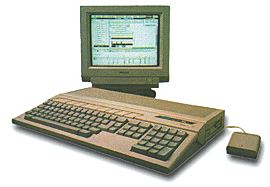|
|
Atari-ST (Little Green Desktop) spec.

ATARI 1040 ST (1986)

| Manufacturer |
Atari |
| Name |
1040
ST |
| Origin |
U.S.A. |
| Year |
1986 |
| CPU |
68000, 8 MHz
|
| RAM |
1024
Kbytes, i.e. 1Mb
|
| ROM |
192
Kbytes, including TOS (the operating system) and GEM (the GUI).
|
| Case |
Very similar to that of the Atari 520ST, but deeper to accommodate the built-in
floppy drive. The case is medium-sized and gray, in the style of the Atari 130XE. It's
adorned with oblique ventilation grills and the ten function keys match the whole design.
There is a power LED at the front left corner of the keyboard and connectors on either
side and the rear. |
| Keyboard |
Controlled by the 6301
CPU. 94 typewriter keys in standard QWERTY layout. There are ten stylish
(not typewriter-style) function keys at the top of the keyboard. Two Alternate keys flank the space bar. A numeric keypad has 18 keys
(including, strangely enough, parentheses). Between the numeric keypad and the
alphanumeric keyboard is a cursor control keypad, like on IBM AT keyboards. It numbers
eight keys, including two wide Help and Undo keys.
|
| Display |
The 1040STF is capable of the same display modes as the Atari 520ST:
- 640 x 400, monochrome. This can only be used with Atari's monochrome monitor.
- 320 x 200, 16 colors chosen from a palette of 512
colors.
- 640 x 200, 4 colors chosen from a palette of 512
colors.
There is no text mode. The computer autodetects the type of monitor connected
and will not use color modes on the monochrome monitor (or vice versa). This was a bad
move (though, admittedly, necessary), in that it forced users to have two monitors if they
were going to play games and run serious applications (that typically used the
monochrome mode).
|
| Audio |
Same as that of the Atari 520ST, controlled by a chip compatible to the famous
AY-3-8910. Although the chip was beginning to show its age in 1985, the relatively fast
CPU on the Atari pushes it beyond its previous capabilities, enabling the machine to
playback digitized samples and make very complicated sound effects. The standard 8910/8912
features are still there, of course: three channels of sound (output separately and mixed
off-chip -- the Atari is mono, by the way), one channel of noise that may be mixed with
any of the three other channels, 16 volume levels and 9 octaves of tones.
What really makes the STF interesting in terms of Audio,
though, is its MIDI port. For this, although its built-in sound is inferior to that of its great
competitor,
the Commodore Amiga 1000, the ST is the best choice for serious music. the In
fact, it's
still used today by musicians all over the world as a MIDI sequencer (among other
things).
The nice thing is that a lot of games would played music through MIDI. So if you
had a synthesizer handy, the music output of the machine got a lot better.
|
| Input/Output |
One built-in 3.5-inch double-sided double-density floppy drive. The device can
store 360 kbytes on single-sided disks or 720 kbytes on double-sided ones. The format and
filesystem of the floppies is MS-DOS compatible (in fact, PCs and Ataris may read each
other's disks easily).
Another, external floppy may be connected to the
machine. There is also a port
to connect external hard drives with a DMA transfer rate of 10 Mbits per
second.
- Midi in port (female 5-pin DIN).
- Midi out port (female 5-pin DIN).
- Parallel printer port.
- Serial RS232 port.
- Floppy drive port.
- Hard disk port.
- ROM cartridge slot (up to 128 kbytes of ROM).
- Two mouse/joystick ports.
- Monitor output (female 13-pin DIN that carries RGB
signals, composite video
output and audio output, allowing anyone who can find a male 13-pin DIN plug to connect
the machine to a SCART TV or a normal composite monitor, as well as to amplify
the machine's sound).
|
| Peripherals |
|
|
|
|
|
Sincerely yours James Cohen Israel. 
|